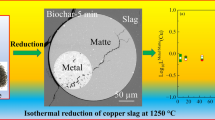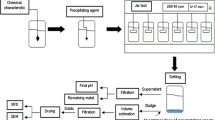Abstract
Processing of spent household batteries to recover manganese and zinc involves grinding of the inner part of battery cells so as to obtain a black powder (BP) with average particle size of less than 2 mm. This is followed by washing the BP with plain water to eliminate soluble chemicals. A subsequent step consists in separating the BP from the aqueous suspension. This operation has proven to be a difficult one. This research showed that adding epichlorohydrin–dimethylamine (EPI–DMA) enhanced greatly the separation process while not inducing unwanted alterations in the chemical composition of the BP. Flocculation efficiency was determined by measuring the solution turbidity. Combining different analytical techniques [X-ray diffraction analysis, scanning electron microscopy, backscattered electrons and zeta potential measurements (Zetasizer Nano)], the research also assessed the effect of EPI–DMA on the solutes, defined the resulting chemical composition of BP and offered an insight into the flocculation mechanism. Central composite design was used to optimize the values of most important operating variables, i.e., EPI–DMA dosage and agitation time of the suspension at different BP/washing water ratios. Analysis of variance was used to study interactions among the process variables and define the conditions of highest separation efficiency.










Similar content being viewed by others
References
Bartolozzi M (1990) The recovery of metals from spent alkaline–manganese batteries: a review of patent literature. Resour Conserv Recycl 4:233–240
Bernardes AM, Espinosa DCR, Tenorio JAS (2003) Collection and recycling of portable batteries: a worldwide overview compared to the Brazilian situation. J Power Sources 124:586–592
Bernardes AM, Espinosa DCR, Tenorio JAS (2004) Recycling of batteries: a review of current processes and technologies. J Power Sources 130:291–298
Veloso LRS, Rodrigues LEOC, Ferreira DA, Magalhaes FS, Mansur MB (2005) Development of a hydrometallurgical route for the recovery of zinc and manganese from spent alkaline batteries. J Power Sources 152:295–302
Sayilgan E, Kukrer T, Civelekoglu G, Ferella F, Akcil A, Vegliò F, Kitis M (2009) A review of technologies for the recovery of metals from spent alkaline and zinc–carbon batteries. J Hydrometall 97:158–166
Toro L, Vegliò F, Beolchini F, Pagnanelli F, Zanetti M, Furlani G (2004) Process and plant for the treatment of run-down batteries, European patent application EP1 684 369
Ferella F, De Michelis I, Vegliò F (2008) Process for the recycling of alkaline and zinc–carbon spent batteries. J Power Sources 183:805–811
De Michelis I, Ferella F, Karakaya E, Beolchini F, Vegliò F (2007) Recovery of zinc and manganese from alkaline and zinc–carbon spent batteries. J Power Sources 172:975–983
Choi JH, Shin WS, Lee SH, Joo DJ, Lee JD (2001) Application of synthetic polyamine flocculants for dye wastewater treatment. J Sep Sci Technol 36(13):2945–2958
Gao BY, Wang Y, Yue QY, Wei JC, Li Q (2007) Color removal from simulated dye water and actual textile wastewater using a composite coagulant prepared by ployferric chloride and polydimethyldiadylammonium chloride. J Sep Purif Technol 54(2):157–163
Wang YF, Gao BY, Yue QY, Zhan X, Si X, Li C (2009) Flocculation performance of epichlorohydrin–dimethylamine polyamine in treating dyeing wastewater. J Environ Manage 91(2):423–431
Yue QY, Gao BY, Wang Y, Zhang H, Sun X, Wang SG, Gu RR (2008) Synthesis of polyamine flocculants and their potential use in treating dye wastewater. J Hazard Mater 152(1):221–227
Matos M, Benito JM, Cambiella A, Coca J, Pazos C (2011) Ultrafiltration of activated sludge: flocculation and membrane fouling. J Desalin 281:142–150
Wang YF, Gao BY, Yue QY, Wang Y, Yang ZL (2012) Removal of acid and direct dye by epichlorohydrin–dimethylamine: flocculation performance and floc aggregation properties. J Bioresour Technol 113:265–271
Bolto B, Gregory J (2007) Organic polyelectrolytes in water treatment. J Water Res 41(11):2301–2324
Wang YF, Gao BY, Yue QY, Wang Y (2011) Effect of viscosity, basicity and organic content of composite flocculant on the decolorization performance and mechanism for reactive dyeing wastewater. J Environ Sci 23(10):1626–1633
Nozaic DJ, Freese SD, Thompson P (2001) Longterm experience in the use of polymeric coagulants at Umgeni Water. J Water Sci Technol Water Supply 1(1):43–50
Choi SY, Park LS, Im SH, Ryoo JJ, Choi SJ, Hwang WJ (1998) Optimization of synthesis condition and determination of residue for polyamine type flocculant. J Korean Ind Eng Chem 9(7):1043–1046
Park LS, Shin JH, Choi SJ, Shin MC, Lee SH (1998) Synthesis of polyamine type flocculant and properties in potable water treatment. J Korean Ind Eng Chem 9(4):542–547
Lee SH, Shin MC, Choi SJ, Shin JH, Park LS (1998) Improvement of flocculation efficiency of water treatment by using polymer flocculants. J Environ Technol 19(4):431–436
Joo DJ, Shin WS, Kim YH, Kim JH, Choi JH, Choi SJ, Park LS (2003) Effect of polyamine flocculant types on dye wastewater treatment. J Sep Sci Technol 38(3):661–678
Montgomery DC (1991) Design and analysis of experiments. Wiley, New York
Orlikovsky NA, Rau EI (2011) Image contrast in the backscattered electron mode in scanning electron microscopy and microtomography. J Bull Russ Acad Sci Phys 75(9):1234–1239
Acknowledgments
Authors are very grateful to Ms. Fabiola Ferrante and Mr. Marcello Centofanti for their helpful collaboration during the AAS and XRF analyses, the Microscopy Centre of l’Aquila University for the SEM and BSE images. S.B. Zueva wishes to express thanks for the financial support from the “Progetto Regionale Speciale Multiasse ‘Reti per l’Alta Formazione’ PO FSE Abruzzo 2007/2013—Azione 4.II.iii adottato con D.R. n. 1564 del 27.09.2011” by University of L’Aquila. A.L. Manciulea wishes to express thanks for the financial support for the project, which was co-financed by the Sectorial Operational Program For Human Resources Development 2007–2013—contract no.: POSDRU/89/1.5/S/60189—“Postdoctoral Programs for Sustainable Development in a Knowledge Based Society.”
Author information
Authors and Affiliations
Corresponding author
Rights and permissions
About this article
Cite this article
Zueva, S.B., Macolino, P., Manciulea, A.L. et al. Polyamine flocculation applied to household batteries recycling. J Mater Cycles Waste Manag 17, 504–512 (2015). https://doi.org/10.1007/s10163-014-0265-7
Received:
Accepted:
Published:
Issue Date:
DOI: https://doi.org/10.1007/s10163-014-0265-7




